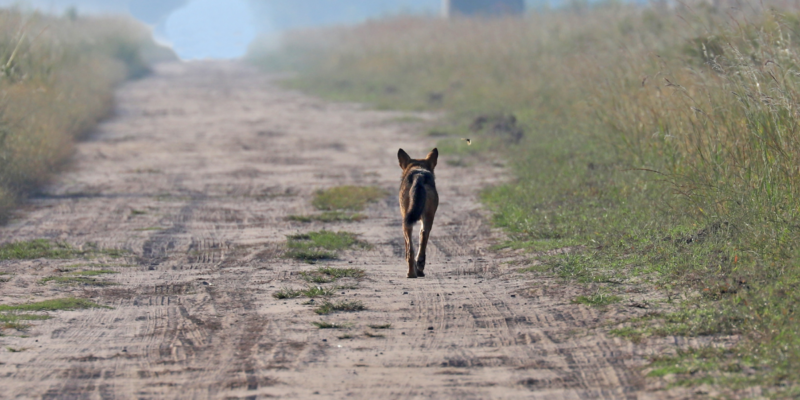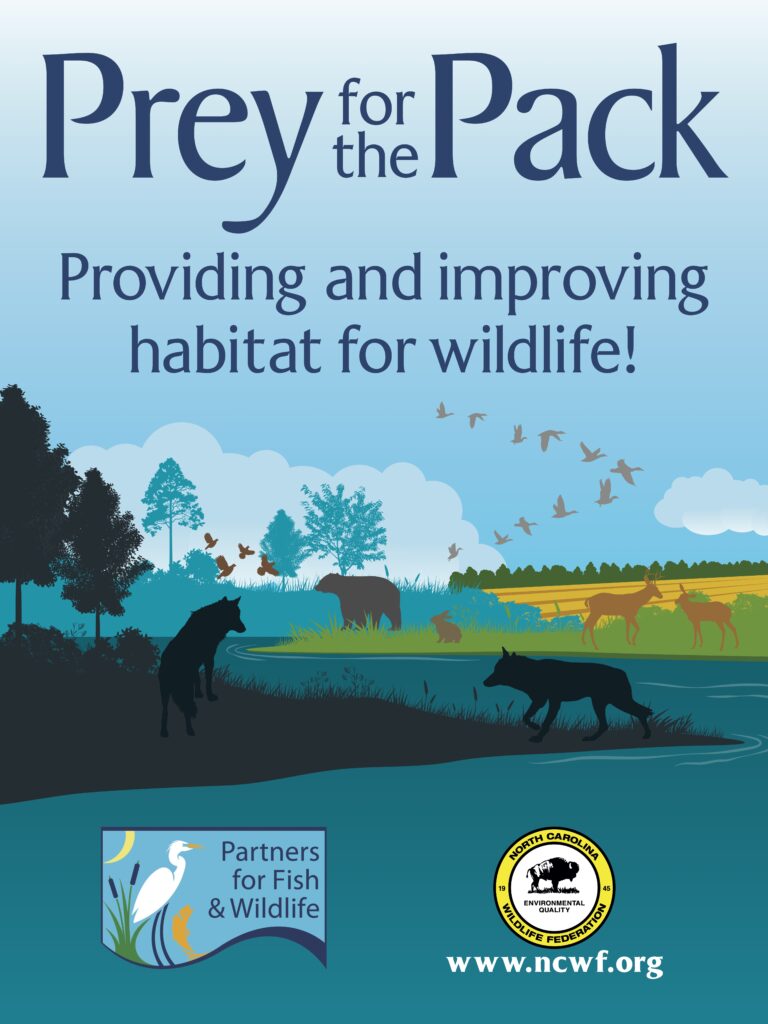Prey for the Pack: Habitat Improvement Program Benefits Private Landowners and Wildlife

Conservation of wildlife begins with habitat.
With the majority of land in North Carolina privately owned, it’s vital for conservation groups to form partnerships with landowners to prevent loss of habitat and wildlife. North Carolina Wildlife Federation works directly with U.S. Fish and Wildlife Service’s Partners for Fish and Wildlife Program to provide technical and financial assistance to landowners for habitat improvement projects that support wildlife while meeting landowner goals.
Prey for the Pack engages private landowners in programming resulting in impactful, on-the-ground habitat work in eastern North Carolina, more specifically the Albemarle-Pamlico Peninsula. The percentage of financial cost share available to qualified private landowners (up to 80%) is based on each habitat improvement plan and the landowner’s willingness to allow Red Wolf-related activities such as monitoring on their land. All project work, including access to private land, is accomplished through coordination and cooperation with all parties involved.
To be considered for the cost-share program, private landowners must commit to improving a pre-identified amount of wildlife habitat on their property and maintaining that habitat in the improved state for 10 years. Properties of all sizes are eligible to apply for the program if they are located within the Eastern North Carolina Red Wolf Population area, consisting of Beaufort, Dare, Hyde, Tyrell and Washington counties. An example of a habitat project is improving and maintaining early successional forested or riparian habitat using forestry mulching, prescribed burning, or native vegetation plantings to increase cover and food for wildlife.
Participating landowners will help determine how the program is incorporated into their land management objectives and may participate in Prey for the Pack in conjunction with other conservation programs. If a landowner wants to show support for Red Wolves and other wildlife by joining Prey for the Pack but is unable to participate in the cost share habitat improvement option, there is a no-cost Pack Member Agreement, which enrolls their property in the program to signify their support for wildlife species and habitat connectivity. All program participants will be offered a Prey for the Pack sign to display at their property.
Habitat, connectivity essential for Red Wolf survival
“North Carolina is the only place in the world with wild Red Wolves, making quality habitat vital to the endangered species’ survival” said Dr. Liz Rutledge, NCWF’s VP of Wildlife Resources.
Habitat quality and connectivity of lands is important for all wildlife to fulfill a variety of biological needs for survival and reproduction.
“As an organization that values biodiversity and the benefits individual species provide to ecosystems, we’ve prioritized the Red Wolf as a species deserving of our resources and expertise,” Rutledge said. “Prey for the Pack is one way we help combat the population’s continual decline while giving landowners a great opportunity to learn about wildlife and achieve their habitat and management objectives.”
A win for wildlife and landowners
“As an avid hunter and owner of hunting property, I know that habitat improvements aren’t a single species endeavor. I joined Prey for Pack and couldn’t be happier. I’ve made significant improvements to my property and have seen fantastic results and all on a timeline that would have been impossible if not for Prey for the Pack assistance.”
“Joining the P4P program has been the best single decision I’ve made since buying my hunting property. Habitat improvements have not only strengthened an endangered species’ chance of survival but increased the deer and bear numbers using my property.”
For more information on Prey for the Pack, contact Luke Lolies, wildlife biologist with the Partners for Fish and Wildlife Program, at luke_lolies@fws.gov or 252-256-3676.
5 Steps for Prey for the Pack Success
1. Identify habitat to improve. Habitat types include forested wetlands, pine stands, native grasslands, riparian areas, and agricultural land.
2. Develop a habitat improvement plan with program staff. The plan will include the work to be done and an associated timeline for
completion.
3. Sign a project agreement. Each agreement is tailored to the landowner, outlining the project responsibilities and details without infringing on property rights or permanently impeding property use. All agreements include a commitment to tolerance of Red Wolves on the enrolled properties.
4. Implement and complete habitat project. Landowners are responsible for project execution and any upfront costs. Once various stages of the habitat improvement are complete, the landowner will submit receipts for cost-share reimbursement. Program staff will provide technical assistance, habitat recommendations, and all project planning and wildlife monitoring.
5. Gain the benefits. Better understand wildlife and habitat on your property, make your land more attractive to wildlife while increasing related recreational opportunities, and receive financial and technical assistance to support your land management goals.
Other ways to support wildlife and habitat in your community
- Help NCWF assemble a local network of conservation-minded
individuals interested in wildlife-related projects, including evaluations
of wildlife crossings, pollinator habitat restoration, marine fisheries and
Red Wolf education. - Become a citizen scientist by installing a trail cam to
capture footage of wildlife on your property and then share your
findings.


